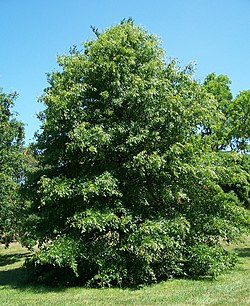Pin oak
| Habit | tree
| |
|---|---|---|
| Lifespan: | ⌛ | perennial |
|
Fagaceae > |
Quercus > |
It is a medium-sized deciduous tree growing to 18-22 m (60-70 ft) tall, with a trunk up to 1 m (3 ft) diameter. It has an 8-14 m (25-45 ft) spread. A 10-year-old tree will be about 8 m (25 ft) tall. The crown is broad conic when young, with numerous small branches radiating out from a central leader. When older, some upper branches become quite large and the central leader is lost, while the lower branches gradually droop downwards.
The leaves are 5-16 cm long and 5-12 cm broad, lobed, with five or seven lobes. Each lobe has 5-7 bristle-tipped teeth. The sinuses are typically u-shaped and extremely deep cut. In fact, there is approximately the same amount of sinus area as actual leaf area. The leaf is mostly hairless, except for a very characteristic tuft of pale orange-brown down on the lower surface where each lobe vein joins the central vein. The acorns, borne in a shallow, thin cap, are hemispherical, 10-16 mm long and 9-15 mm broad, green maturing pale brown about 18 months after pollination. The acorn is unpalatable because the kernel is very bitter.
It is not a long-lived tree, usually living only 90 to 120 years. It is naturally a wetland tree, and develops a shallow, fibrous root system, unlike many oaks, which have a strong, deep taproot when young. It is confined to acidic soils, and does not tolerate limestone, and grows at low altitudes from sea level up to 350 m. The specific name palustris means "of swamps".
A feature of Pin oak (shared by a few other oak species, and also some beeches and hornbeams) is the retention of leaves through the winter on juvenile tissue. Young trees under 6 m (20 ft) will often be covered with leaves year-round, though the leaves die in the fall, remaining attached to the shoots until the new leaves appear in the spring. As with many other oak species, dead Pin oak branches will stay on the tree for many years.
Key Characteristics:
The acorns are small with a thin, shallow cap.
The pin oak is in the red oak subgenus: pointed lobes.
The sinuses are very deeply cut and u-shaped.
The amount of sinus area is approximately equivalent to the amount of actual leaf area.
The upper branches point upwards, the middle branches are perpendicular to trunk, and the lower branches angle down.
Pin oak is monoecious; flowers appear at about the time the leaves develop in the spring. Staminate flowers are borne on aments that develop from buds formed in the leaf axils of the previous year, and pistillate flowers are borne on short stalks from the axils of current-year leaves. Pollination is by wind. Fruit is an acorn (nut) that matures at the end of the second growing season after flowering. Acorns are dispersed from September to early December.
Read about Pin oak in the Standard Cyclopedia of Horticulture
|
|---|
|
Quercus palustris, Linn. Pin Oak. Tree, to 80, occasionally 120 ft., with rather short spreading branches, forming a symmetrical pyramidal head, becoming irregular and oblong in older trees: lvs. deeply pinnatifid, sometimes almost to the midrib; lobes 5-7, oblong or oblong-lanceolate, toothed, separated by wide sinuses, bright green above, light green oblong -lanceolate toothed separated by wide sinuses bright green above light green beneath, with axillary tufts of hairs, 3-5 in. long: fr. short-stalked; acorn subglobose or ovoid, 1/3—1/2in. long, embraced about one-third or more by the cup. Mass., to Del., west to Wis.and Ark.—Handsome trees, especially when young; often used for avenues; grows rapidly and prefers somewhat moist soil; foliage bright red in autumn. The tree is fibrous-rooted and transplants well. Hybrids of this with the preceding species and with Q. Phellos have been observed in cult.
|
Cultivation
Pin oak grows primarily on level or nearly level, poorly drained alluvial floodplain and river bottom soils with high clay content. Pin oak is usually found on sites that flood intermittently during the dormant season but do not ordinarily flood during the growing season. It does not grow on the lowest, most poorly drained sites that may be covered with standing water through much of the growing season. However, it does grow extensively on poorly drained upland "pin oak flats" on the glacial till plains of southwestern Ohio, southern Illinois and Indiana, and northern Missouri. The level topography and presence of a claypan in the soil of these areas cause these sites to be excessively wet in winter and spring.
Pin oak is classed as intolerant of shade.
Propagation
Pests and diseases
Species
Gallery
If you have a photo of this plant, please upload it! Plus, there may be other photos available for you to add.
- Pin oak leaves.jpg
Pin oak leaves
- Pin oak range.jpg
Natural range of the pin oak
- Pin oak tree 2.jpg
Pin oak with drooping lower branches, parallel middle brances, and ascending upper branches
- Pin-oak tree 1.jpg
References
- Standard Cyclopedia of Horticulture, by L. H. Bailey, MacMillan Co., 1963
External links
- w:Pin oak. Some of the material on this page may be from Wikipedia, under the Creative Commons license.
- Pin oak QR Code (Size 50, 100, 200, 500)

